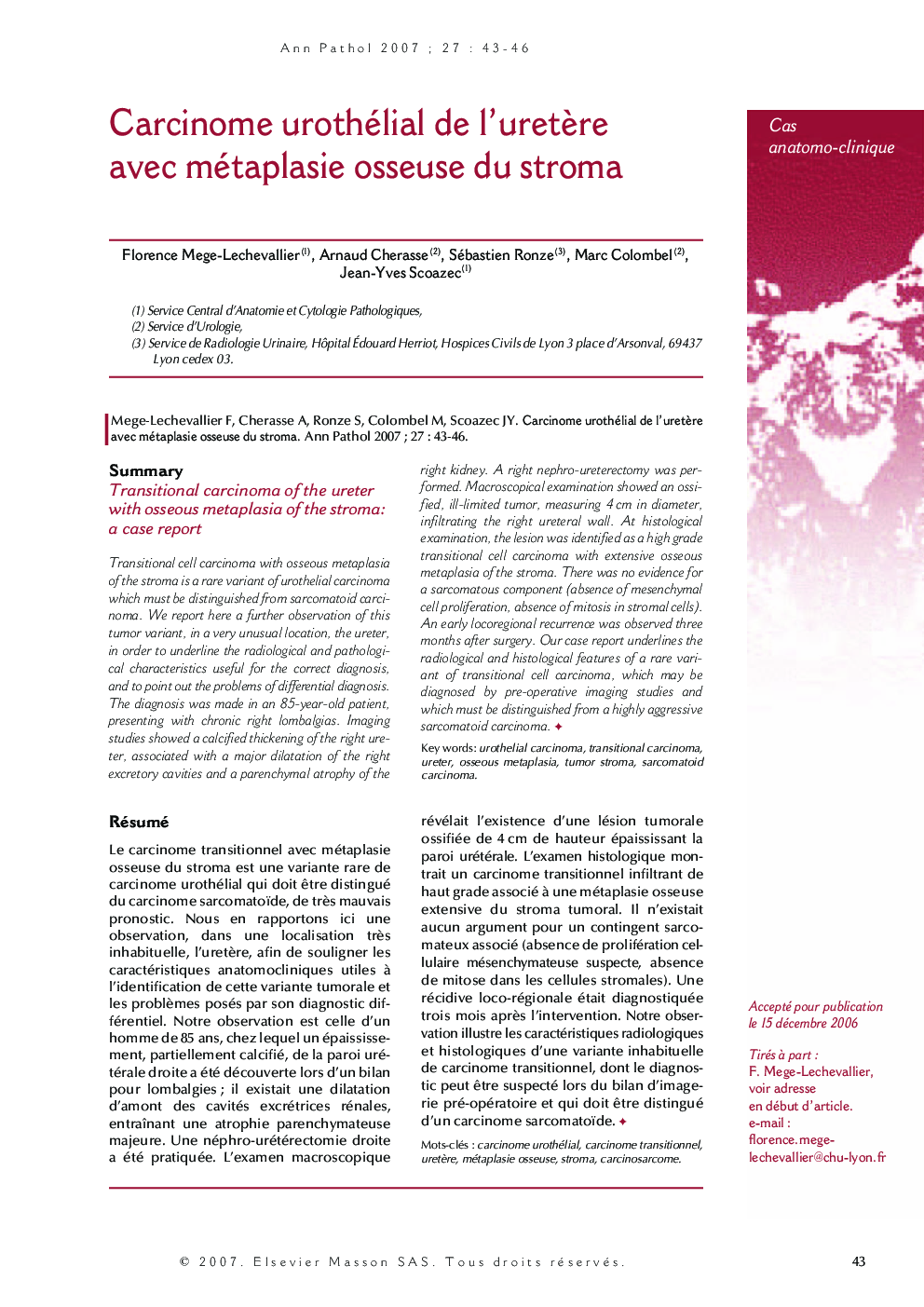| Article ID | Journal | Published Year | Pages | File Type |
|---|---|---|---|---|
| 4129401 | Annales de Pathologie | 2007 | 4 Pages |
RésuméLe carcinome transitionnel avec métaplasie osseuse du stroma est une variante rare de carcinome urothélial qui doit être distingué du carcinome sarcomatoïde, de très mauvais pronostic. Nous en rapportons ici une observation, dans une localisation très inhabituelle, l'uretère, afin de souligner les caractéristiques anatomocliniques utiles à l'identification de cette variante tumorale et les problèmes posés par son diagnostic différentiel. Notre observation est celle d'un homme de 85 ans, chez lequel un épaississement, partiellement calcifié, de la paroi urétérale droite a été découverte lors d'un bilan pour lombalgies ; il existait une dilatation d'amont des cavités excrétrices rénales, entraînant une atrophie parenchymateuse majeure. Une néphro-urétérectomie droite a été pratiquée. L'examen macroscopique révélait l'existence d'une lésion tumorale ossifiée de 4 cm de hauteur épaississant la paroi urétérale. L'examen histologique montrait un carcinome transitionnel infiltrant de haut grade associé à une métaplasie osseuse extensive du stroma tumoral. Il n'existait aucun argument pour un contingent sarcomateux associé (absence de prolifération cellulaire mésenchymateuse suspecte, absence de mitose dans les cellules stromales). Une récidive loco-régionale était diagnostiquée trois mois après l'intervention. Notre observation illustre les caractéristiques radiologiques et histologiques d'une variante inhabituelle de carcinome transitionnel, dont le diagnostic peut être suspecté lors du bilan d'imagerie pré-opératoire et qui doit être distingué d'un carcinome sarcomatoïde.
SummaryTransitional cell carcinoma with osseous metaplasia of the stroma is a rare variant of urothelial carcinoma which must be distinguished from sarcomatoid carcinoma. We report here a further observation of this tumor variant, in a very unusual location, the ureter, in order to underline the radiological and pathological characteristics useful for the correct diagnosis, and to point out the problems of differential diagnosis. The diagnosis was made in an 85-year-old patient, presenting with chronic right lombalgias. Imaging studies showed a calcified thickening of the right ureter, associated with a major dilatation of the right excretory cavities and a parenchymal atrophy of the right kidney. A right nephro-ureterectomy was performed. Macroscopical examination showed an ossified, ill-limited tumor, measuring 4 cm in diameter, infiltrating the right ureteral wall. At histological examination, the lesion was identified as a high grade transitional cell carcinoma with extensive osseous metaplasia of the stroma. There was no evidence for a sarcomatous component (absence of mesenchymal cell proliferation, absence of mitosis in stromal cells). An early locoregional recurrence was observed three months after surgery. Our case report underlines the radiological and histological features of a rare variant of transitional cell carcinoma, which may be diagnosed by pre-operative imaging studies and which must be distinguished from a highly aggressive sarcomatoid carcinoma.
